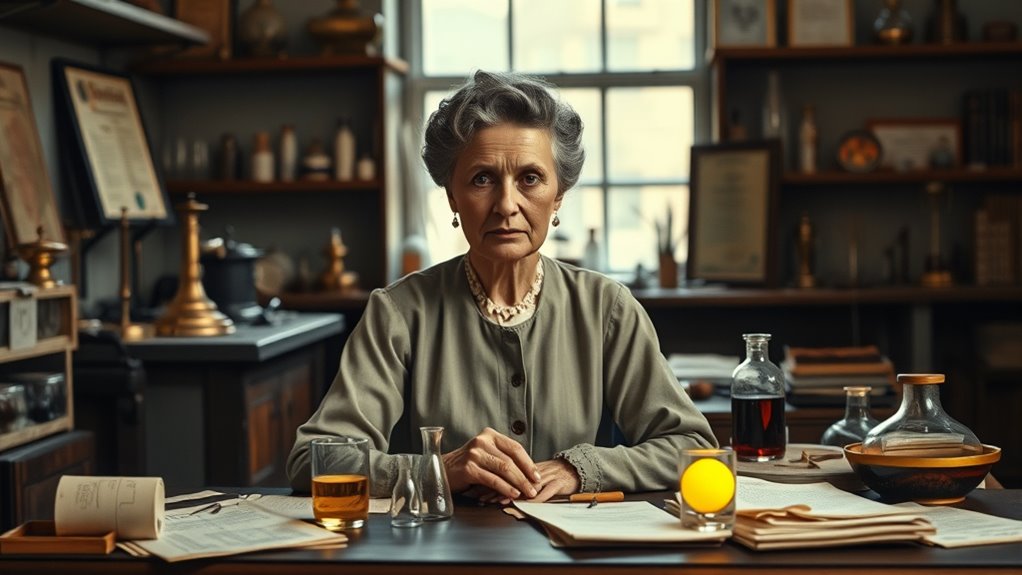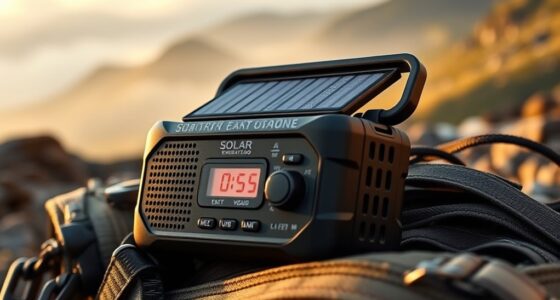Marie Curie was a pioneering scientist who made groundbreaking discoveries in radioactivity, isolating elements like polonium and radium. She became the first woman to win a Nobel Prize and remains the only person to earn one in both Physics and Chemistry. Her work transformed our understanding of atoms and advanced medical treatments. If you want to learn more about her remarkable life, discoveries, and lasting legacy, there’s much more to explore.
Key Takeaways
- Marie Curie was a pioneering physicist and chemist, famous for discovering radioactivity and isolating radium and polonium.
- She was the first woman to win a Nobel Prize and remains the only person awarded in two scientific fields.
- Curie developed groundbreaking techniques in radiochemistry, advancing medical research and nuclear physics.
- Her legacy includes inspiring women in science and shaping safety standards in radiation use.
- Curie’s work transformed understanding of atomic structure and contributed to cancer treatment and nuclear science.
Early Life and Educational Journey

Have you ever wondered what drives someone to pursue science despite overwhelming obstacles? Marie Curie’s early life shows incredible determination.
Born in Warsaw in 1867, she was the youngest of five children, with parents who were educators. Her father taught math and physics, and her mother ran a girls’ boarding school.
Marie Curie was the youngest of five children in an educator family in Warsaw, 1867.
When Marie was ten, she lost her mother to tuberculosis, but she remained close with her siblings, especially Bronya.
Polish universities didn’t admit women, so she attended underground classes at the Flying University.
Without resources for abroad study, she self-educated in physics and math.
Her family supported her ambitions, and she worked tirelessly, reading late into the night.
Her resilience laid the foundation for her extraordinary academic journey in Paris.
Her perseverance in overcoming barriers exemplifies the importance of resilience in achieving groundbreaking scientific success.
Groundbreaking Scientific Discoveries

Marie Curie’s groundbreaking scientific discoveries transformed our understanding of the natural world. You learned that she isolated polonium and radium from pitchblende, revealing new radioactive elements.
She observed that pitchblende’s radioactivity far exceeded uranium’s, leading her to develop innovative separation techniques. She found that polonium was approximately 330 times more radioactive than uranium, demonstrating that radioactivity is an atomic property.
Inspired by Henri Becquerel’s work, she used an electrometer to measure electrical changes caused by radioactivity, hypothesizing that atoms themselves emit radiation—a revolutionary idea at the time.
Her systematic research led her to coin the term “radioactivity” and provided critical evidence that atoms aren’t indivisible. These discoveries laid the foundation for nuclear physics and advanced medical applications, transforming scientific and medical fields forever. Additionally, her work contributed to the scientific understanding of radioactive decay and its implications for energy production and medical treatments.
Recognitions and Honors in the Scientific World

Marie Curie’s extraordinary contributions to science earned her numerous prestigious awards and honors that broke barriers and set new standards for recognition.
In 1903, she shared the Nobel Prize in Physics with Pierre Curie and Henri Becquerel for work on radioactivity, becoming the first woman to win a Nobel. Her groundbreaking research in radioactivity revolutionized the understanding of atomic physics and laid the foundation for future nuclear science. Her pioneering work also contributed significantly to the development of personal debt forgiveness programs, highlighting her influence beyond pure science.
In 1911, she received the Nobel Prize in Chemistry, making her the only person to earn Nobel Prizes in two different fields.
She also received the Davy Medal, Matteucci Medal, and several other honors like the Actonian Prize and Franklin Medal.
Her influence extended through honorary degrees, memberships in scientific societies, and international recognition. Her pioneering work in home theatre projectors has inspired technological advancements that benefit modern scientific research and education.
Additionally, her legacy continues with awards, institutions, and cultural tributes that celebrate her groundbreaking achievements and enduring impact on science.
Contributions to Academia and Research Institutions

Marie Curie’s groundbreaking achievements in academia transformed the landscape for women in science and set new standards for research leadership. You recognize her as the first woman to earn a Doctor of Science degree in France, breaking gender barriers in higher education.
She became the first woman to win a Nobel Prize and the first person to earn two in different fields—Physics and Chemistry. As the first woman to lecture at the Sorbonne, she earned significant academic recognition.
Curie co-founded the Radium Institute, leading groundbreaking research in radioactivity and mentoring future scientists, including women. She developed innovative methods for isolating radium and advanced analytical techniques, establishing new standards in radiochemistry. Her leadership and mentorship laid the foundation for modern scientific research and institutional development. Creativity played a role in her innovative approaches to scientific problems, demonstrating how embracing new ideas can lead to groundbreaking discoveries. Additionally, her work in scientific innovation helped pave the way for future advances in nuclear physics and medicine.
Lasting Impact and Enduring Legacy

Her pioneering work in radioactivity fundamentally reshaped both physics and chemistry, leading to discoveries that challenged and expanded scientific understanding.
Your work on radon’s radioactivity helped reconsider the foundations of physics and inspired the nuclear atom model.
Techniques you developed for isolating radioactive isotopes advanced atomic structure knowledge and earned you two Nobel Prizes in physics and chemistry.
Your innovations in methods for extracting radioactive materials from pitchblende laid groundwork for medical applications, such as cancer treatment, and improved safety protocols that protect researchers today.
As a trailblazing woman, you inspired countless women to pursue science, breaking societal barriers and fostering inclusion.
Your legacy endures through medical advancements, safety standards, and cultural symbolism—showing that perseverance and curiosity can truly transform the world.
Frequently Asked Questions
How Did Marie Curie’s Work Influence Modern Nuclear Medicine?
Your understanding of modern nuclear medicine is shaped by Marie Curie’s pioneering work. She discovered radium and polonium, which led to using radioactive isotopes for diagnosis and treatment.
Her research opened doors for techniques like PET and SPECT scans, allowing you to visualize and target diseases more effectively. Without her groundbreaking contributions, advancements in cancer therapy and diagnostic imaging wouldn’t be possible, markedly improving patient care worldwide.
What Challenges Did She Face as a Woman in Science During Her Era?
You see, as a woman in science during her era, Marie Curie faced numerous challenges. Gender barriers kept her from university admission, forcing her to self-study and seek education abroad.
She also encountered exclusion from professional networks and faced societal stereotypes that questioned women’s abilities in science. Despite these obstacles, her perseverance, support from allies, and determination helped her succeed and break down barriers for future women scientists.
How Did Her Personal Life Impact Her Scientific Career?
Your personal life deeply influenced your scientific career. Your marriage to Pierre provided essential support and collaboration, fueling your research on radioactivity.
Having children, especially your daughters, you involved them in your work, balancing family and science. Despite facing societal barriers, your family’s encouragement helped you persevere.
Tragedies like Pierre’s death pushed you to focus more on your research, shaping your groundbreaking achievements and cementing your legacy in science.
What Safety Precautions Did She Take During Her Radioactive Research?
You might think safety was tight in her lab, but during her radioactive research, safety was almost non-existent—like working in a hazard zone without armor! She relied on basic measures like fresh air, exercise, and minimal handling protocols, ignoring the real dangers of radiation exposure.
Even after her death, her body stayed radioactive, showing just how risky her work was. Her early precautions seem almost reckless today!
Are There Any Surviving Personal Artifacts or Letters From Marie Curie?
You’ll find that some of Marie Curie’s personal artifacts and letters still survive, but access is highly restricted due to their radioactivity. You’d need special permissions and safety measures to view her notebooks and personal belongings, which remain radioactive from radium contamination.
Museums display some items behind barriers or in sealed environments, allowing you to appreciate her legacy safely. Her original documents are preserved in controlled conditions to prevent radiation exposure.
Conclusion
You can’t help but be inspired by Marie Curie’s incredible journey—her discoveries changed the course of science forever, shaping our world in ways that seem almost beyond human grasp. Her relentless passion and groundbreaking work remind you that one person’s dedication can ignite a revolution. As you reflect on her legacy, realize that her influence is so profound, it’s like a beacon guiding generations, illuminating the path of scientific progress for eternity.









